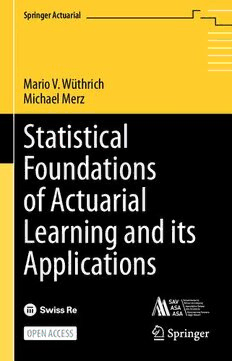Table Of ContentSpringer Actuarial
Mario V. Wüthrich
Michael Merz
Statistical
Foundations
of Actuarial
Learning and its
Applications
Springer Actuarial
Editors-in-Chief
HansjoergAlbrecher,UniversityofLausanne,Lausanne,Switzerland
MichaelSherris,UNSW,Sydney,NSW,Australia
SeriesEditors
DanielBauer,UniversityofWisconsin-Madison,Madison,WI,USA
StéphaneLoisel,ISFA,UniversitéLyon1,Lyon,France
AlexanderJ.McNeil,UniversityofYork,York,UK
AntoonPelsser,MaastrichtUniversity,Maastricht,TheNetherlands
ErmannoPitacco,UniversitàdiTrieste,Trieste,Italy
GordonWillmot,UniversityofWaterloo,Waterloo,ON,Canada
HailiangYang,TheUniversityofHongKong,HongKong,HongKong
Thisis a seriesonactuarialtopicsina broadandinterdisciplinarysense, aimedat
students,academicsandpractitionersinthefieldsofinsuranceandfinance.
Springer Actuarial informs timely on theoretical and practical aspects of top-
ics like risk management, internal models, solvency, asset-liability management,
market-consistent valuation, the actuarial control cycle, insurance and financial
mathematics,andotherrelatedinterdisciplinaryareas.
Theseriesaimstoserveasaprimaryscientificreferenceforeducation,research,
developmentandmodelvalidation.
The type of material considered for publication includes lecture notes, mono-
graphsandtextbooks.Allsubmissionswillbepeer-reviewed.
Mario V. Wüthrich (cid:129) Michael Merz
Statistical Foundations
of Actuarial Learning
and its Applications
MarioV.Wüthrich MichaelMerz
DepartmentofMathematics,RiskLab FacultyofBusinessAdministration
Switzerland UniversityofHamburg
ETHZürich Hamburg,Germany
Zürich,Switzerland
ThisworkwassupportedbySchweizerischeAktuarvereinigungSAVandSwissRe.
ISSN2523-3262 ISSN2523-3270 (electronic)
SpringerActuarial
ISBN978-3-031-12408-2 ISBN978-3-031-12409-9 (eBook)
https://doi.org/10.1007/978-3-031-12409-9
MathematicsSubjectClassification:C13,C21/31,C24/34,G22,62F10,62F12,62J07,62J12,62M45,
62P05,68T01,68T50
©TheAuthors2023.Thisbookisanopenaccesspublication.
Open Access This bookis licensed under the terms of the Creative Commons Attribution 4.0Inter-
nationalLicense(http://creativecommons.org/licenses/by/4.0/), whichpermitsuse,sharing,adaptation,
distribution andreproduction inanymediumorformat,aslong asyougive appropriate credit tothe
originalauthor(s)andthesource,providealinktotheCreativeCommonslicenseandindicateifchanges
weremade.
Theimages or other third party material in this book are included in the book’s Creative Commons
license,unlessindicatedotherwiseinacreditlinetothematerial.Ifmaterialisnotincludedinthebook’s
CreativeCommonslicenseandyourintendeduseisnotpermittedbystatutoryregulationorexceedsthe
permitteduse,youwillneedtoobtainpermissiondirectlyfromthecopyrightholder.
Theuseofgeneraldescriptivenames,registerednames,trademarks,servicemarks,etc.inthispublication
doesnotimply,evenintheabsenceofaspecificstatement,thatsuchnamesareexemptfromtherelevant
protectivelawsandregulationsandthereforefreeforgeneraluse.
Thepublisher,theauthors,andtheeditorsaresafetoassumethattheadviceandinformationinthisbook
arebelievedtobetrueandaccurateatthedateofpublication.Neitherthepublishernortheauthorsor
theeditorsgiveawarranty,expressedorimplied,withrespecttothematerialcontainedhereinorforany
errorsoromissionsthatmayhavebeenmade.Thepublisherremainsneutralwithregardtojurisdictional
claimsinpublishedmapsandinstitutionalaffiliations.
ThisSpringerimprintispublishedbytheregisteredcompanySpringerNatureSwitzerlandAG
Theregisteredcompanyaddressis:Gewerbestrasse11,6330Cham,Switzerland
Acknowledgments
We kindly thank our very generous sponsors, the Swiss Association of Actuaries
(SAA)andSwissRe,forfinancingtheopenaccessoptionoftheelectronicversion
of this book. Our special thanks go to Sabine Betz (President of SAA), Adrian
Kolly(SwissRe),andHolgerWalz(SAA)whowereverypositiveandinterestedin
thisbookprojectfromtheverybeginning,andwhomadethisopenaccessfunding
possiblewithintheirinstitutions.
A very special thank you goes to Hans Bühlmann who has been supportingus
overthelast30years.Wehavehadsomanyinspiringdiscussionsovertheseyears,
and we have greatly benefited and learned from Hans’ incredible knowledge and
intuition.
JointlywithChristophBuser,wehavestartedtoteachthelecture“DataAnalytics
forNon-LifeInsurancePricing”atETHZurichin2018.Ourdataanalyticslecture
focuses(only)onthePoissonclaimcountscase,butitslecturenoteshaveprovided
a first draft for this book project. This draft has been developed and extended to
the generalcase of the exponentialfamily.Since our firstlecture, we have greatly
benefited from interactions with many colleagues and students. In particular, we
would like to mention the data science initiative “Actuarial Data Science” of the
Swiss Association of Actuaries (chaired by Jürg Schelldorfer), whose tutorials
providedagreatstimulusforthisbook.Moreover,wementiontheannualInsurance
DataScienceConference(chairedbyMarkusGesmannandAndreasTsanakas)and
the ASTIN Reading Club (chairedby Ronald Richman and Dimitri Semenovich).
Furthermore,wewouldliketokindlythankRonaldRichmanwhohasalwaysbeen
adrivingforcebehindlearningandadaptingnewmachinelearningtechniques,and
wealsokindlythankSimonRentzmannformanyinterestingdiscussionsonhowto
applythesetechniquesonrealinsuranceproblems.
We thank the following colleagues by name (in alphabetical order). We col-
laborated and had inspiring discussions in the field of statistical learning with
the following colleagues: Johannes Abegglen, Hansjörg Albrecher, Davide Apol-
loni, Peter Bühlmann, Christoph Buser, Patrick Cheridito, Łukasz Delong, Paul
Embrechts,AndreaFerrario,TobiasFissler,LucaFontana,DaisukeFrei,TszChai
Fung, Guangyuan Gao, Yan-Xing Lan, Gee Lee, Mathias Lindholm, Christian
v
vi Acknowledgments
Lorentzen,FriedrichLoser,MichaelMayer,DanielMeier,AlexanderNoll,Gareth
Peters, Jan Rabenseifner, Peter Reinhard, Simon Rentzmann, Ronald Richman,
Ludger Rüschendorf, Robert Salzmann, Marc Sarbach, Jürg Schelldorfer, Pavel
Shevchenko,JoëlThomann,AndreasTsanakas,GeorgeTzougas,EmilianoValdez,
TimVerdonck,andPatrickZöchbauer.
Contents
1 Introduction................................................................. 1
1.1 TheStatisticalModelingCycle ..................................... 1
1.2 PreliminariesonProbabilityTheory ................................ 3
1.3 Lab:ExploratoryDataAnalysis .................................... 7
1.4 OutlineofThisBook ................................................ 9
2 ExponentialDispersionFamily ........................................... 13
2.1 ExponentialFamily .................................................. 13
2.1.1 DefinitionandProperties .................................. 13
2.1.2 Single-ParameterLinearEF:CountVariable
Examples ................................................... 18
2.1.3 Vector-ValuedParameter EF: Absolutely
ContinuousExamples ...................................... 20
2.1.4 Vector-ValuedParameterEF:CountVariable
Example .................................................... 27
2.2 ExponentialDispersionFamily ..................................... 28
2.2.1 DefinitionandProperties .................................. 28
2.2.2 ExponentialDispersionFamilyExamples ................ 31
2.2.3 Tweedie’sDistributions .................................... 34
2.2.4 SteepnessoftheCumulantFunction ...................... 37
2.2.5 Lab:LargeClaimsModeling .............................. 38
2.3 InformationGeometryinExponentialFamilies .................... 40
2.3.1 Kullback–LeiblerDivergence ............................. 40
2.3.2 UnitDevianceandBregmanDivergence ................. 42
3 EstimationTheory.......................................................... 49
3.1 IntroductiontoDecisionTheory .................................... 49
3.2 ParameterEstimation ................................................ 51
3.3 UnbiasedEstimators ................................................. 56
3.3.1 Cramér–RaoInformationBound .......................... 56
3.3.2 InformationBoundintheExponentialFamily
Case ......................................................... 62
vii
viii Contents
3.4 AsymptoticBehaviorofEstimators ................................ 67
3.4.1 Consistency ................................................ 67
3.4.2 AsymptoticNormality ..................................... 69
4 PredictiveModelingandForecastEvaluation........................... 75
4.1 GeneralizationLoss ................................................. 75
4.1.1 MeanSquaredErrorofPrediction ........................ 76
4.1.2 UnitDeviancesandDevianceGeneralization
Loss ......................................................... 79
4.1.3 ADecision-TheoreticApproachtoForecast
Evaluation .................................................. 88
4.2 Cross-Validation ..................................................... 95
4.2.1 In-SampleandOut-of-SampleLosses .................... 95
4.2.2 Cross-ValidationTechniques .............................. 98
4.2.3 Akaike’sInformationCriterion ............................ 103
4.3 Bootstrap ............................................................. 106
4.3.1 Non-parametricBootstrapSimulation .................... 106
4.3.2 ParametricBootstrapSimulation .......................... 109
5 GeneralizedLinearModels................................................ 111
5.1 GeneralizedLinearModelsandLog-Likelihoods ................. 112
5.1.1 RegressionModeling ...................................... 112
5.1.2 DefinitionofGeneralizedLinearModels ................. 113
5.1.3 LinkFunctionsandFeatureEngineering ................. 115
5.1.4 Log-LikelihoodFunction and Maximum
LikelihoodEstimation ..................................... 116
5.1.5 BalancePropertyUndertheCanonicalLink
Choice ...................................................... 122
5.1.6 AsymptoticNormality ..................................... 123
5.1.7 MaximumLikelihoodEstimation andUnit
Deviances .................................................. 124
5.2 ActuarialApplicationsofGeneralizedLinearModels............. 126
5.2.1 SelectionofaGeneralizedLinearModel ................. 126
5.2.2 FeatureEngineering ....................................... 127
5.2.3 Offsets ...................................................... 132
5.2.4 Lab: Poisson GLM for Car Insurance
Frequencies ................................................. 133
5.3 ModelValidation .................................................... 141
5.3.1 ResidualsandDispersion .................................. 141
5.3.2 HypothesisTesting ......................................... 145
5.3.3 AnalysisofVariance ....................................... 147
5.3.4 Lab: Poisson GLM for Car Insurance
Frequencies,Revisited ..................................... 150
5.3.5 Over-DispersioninClaimCountsModeling ............. 155
5.3.6 Zero-InflatedPoissonModel .............................. 162
5.3.7 Lab:GammaGLMforClaimSizes ....................... 167
Contents ix
5.3.8 Lab:InverseGaussianGLMforClaimSizes ............. 173
5.3.9 Log-NormalModelforClaimSizes:AShort
Discussion .................................................. 176
5.4 Quasi-Likelihoods ................................................... 180
5.5 DoubleGeneralizedLinearModel .................................. 182
5.5.1 TheDispersionSubmodel ................................. 182
5.5.2 SaddlepointApproximation ............................... 183
5.5.3 ResidualMaximumLikelihoodEstimation ............... 186
5.5.4 Lab:DoubleGLMAlgorithmforGammaClaim
Sizes ........................................................ 187
5.5.5 Tweedie’sCompoundPoissonGLM ...................... 189
5.6 DiagnosticTools ..................................................... 190
5.6.1 TheHatMatrix ............................................. 190
5.6.2 CaseDeletionandGeneralizedCross-Validation ........ 192
5.7 GeneralizedLinearModelswithCategoricalResponses .......... 195
5.7.1 LogisticCategoricalGeneralizedLinearModel .......... 195
5.7.2 MaximumLikelihoodEstimationinCategorical
Models ...................................................... 196
5.8 FurtherTopicsofRegressionModeling ............................ 198
5.8.1 LongitudinalDataandRandomEffects .................. 198
5.8.2 Regression Models Beyond the GLM
Framework ................................................. 199
5.8.3 QuantileRegression ....................................... 202
6 BayesianMethods,Regularization
andExpectation-Maximization........................................... 207
6.1 BayesianParameterEstimation ..................................... 207
6.2 Regularization ....................................................... 210
6.2.1 MaximalaPosteriorEstimator ............................ 210
6.2.2 Ridgevs.LASSORegularization ......................... 212
6.2.3 RidgeRegression .......................................... 215
6.2.4 LASSORegularization .................................... 217
6.2.5 GroupLASSORegularization ............................ 226
6.3 Expectation-MaximizationAlgorithm .............................. 230
6.3.1 MixtureDistributions ...................................... 230
6.3.2 IncompleteandCompleteLog-Likelihoods .............. 232
6.3.3 Expectation-MaximizationAlgorithmfor
Mixtures .................................................... 233
6.3.4 Lab:MixtureDistributionApplications .................. 240
6.4 TruncatedandCensoredData ....................................... 248
6.4.1 Lower-TruncationandRight-Censoring .................. 248
6.4.2 ParameterEstimationUnderRight-Censoring ........... 250
6.4.3 ParameterEstimationUnderLower-Truncation .......... 254
6.4.4 CompositeModels ......................................... 264

